They might not be raindrops on roses or whiskers on kittens, but that doesn’t mean that we love them any less. Welcome back to My Favorite Things, the weekly column where we grab someone in speculative circles to gab about the greatest in geek. This week, we sit down with Kate Story, whose next book, Antilia: Seer and Sacrifice, comes out from ChiTeen on May 21st, 2019, and it is the final installment of the Antilia duology.
What does Kate love when she’s not writing about the future meshing with magic? Spoiler alert: lyrical fantasy, shape-shifting swans, a writer who might’ve actually been a wizard, enchanting spiritualism, a future we don’t have yet, a writer whose work has seen into the future, a YA that’s winning all the things, and a gateway to the Fairy. Curious? Read on to learn more!
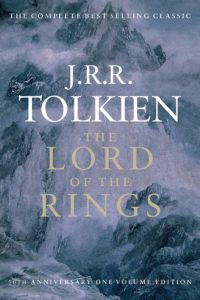 I was ten the first time I read The Lord of the Rings, something I was super proud of until I met a bastard person who had read them at nine. I re-read them annually for about a decade, and have since periodically returned to the fountain. The hobbits! The magic! The horror! The moral weight! That part which always makes me cry where Frodo realizes the quest is his to bear:
I was ten the first time I read The Lord of the Rings, something I was super proud of until I met a bastard person who had read them at nine. I re-read them annually for about a decade, and have since periodically returned to the fountain. The hobbits! The magic! The horror! The moral weight! That part which always makes me cry where Frodo realizes the quest is his to bear:
“I will take the ring,” he said, “though I do not know the way.”
The rhythm in that deceptively simple prose! The too-much-poetry/song lyrics-that-you-can-just-skip-over-if-you-feel-like-it! I was a bit unnerved by the lack of female characters, so I made one up — a hobbit, of course, with red hair, of course, who shadowed the Nine Walkers. (Okay, I know there’s Arwen and Galadriel and Éowyn. Arwen just sits around weaving a flag, then gives up her elven magic and immortality to get married; Galadriel is far too terrible and remote and lovely for me to relate to; and while I approved of Éowyn dressing like a man and going into battle, she is, at that point, suicidal — which at that stage of my life didn’t speak to me.) I spent an inordinate amount of time and energy strategizing about ways to insert my character into the narrative without spoiling the plot as Tolkien has it. I think now that all this preoccupation with colonizing a beloved masculinist narrative set me up perfectly for the Shakespearian SF interventions I’ve been fortunate enough to have published.
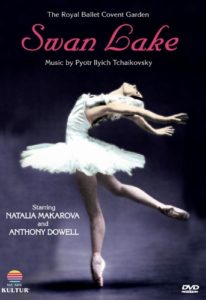 I started out in dance as a kid, and moved on to experimental theatre later. I remember seeing Swan Lake on my aunt’s tiny grainy black and white TV that sat atop her fridge — I believe it was The Royal Ballet’s production and I know it starred Natalia Makarova. When, at the end, she is dying, she really looked like a swan — her body was no longer human — and I crept slowly across the kitchen floor, transfixed, until I was right up against the old fridge with my head cranked back staring at the screen. Swan Lake has it all — an evil magician, an interfering mother, an immature prince, a shapeshifting swan woman, an evil sexy double, betrayal, and at the end love/death conquers all! This is the kind of story ballet does and nobody says, “that’s genre and therefore inferior” — it’s just part of the canon, as it should be.
I started out in dance as a kid, and moved on to experimental theatre later. I remember seeing Swan Lake on my aunt’s tiny grainy black and white TV that sat atop her fridge — I believe it was The Royal Ballet’s production and I know it starred Natalia Makarova. When, at the end, she is dying, she really looked like a swan — her body was no longer human — and I crept slowly across the kitchen floor, transfixed, until I was right up against the old fridge with my head cranked back staring at the screen. Swan Lake has it all — an evil magician, an interfering mother, an immature prince, a shapeshifting swan woman, an evil sexy double, betrayal, and at the end love/death conquers all! This is the kind of story ballet does and nobody says, “that’s genre and therefore inferior” — it’s just part of the canon, as it should be.
Le Guin. Just… Le Guin, as in Ursula K. I love everything she’s written. Okay, maybe I am always just a wee bit disappointed when I read her non-spec stuff, but who cares, it’s still beautifully written! Her prose isn’t fancy, but it’s beautiful and just, and it takes you along until near the end you find yourself crying and you’re not sure why. I love her Hainish books — what a glorious framework for creating and exploring multiple worlds! — and I love the gentle, pacifist, honest societies and characters she creates. By taking her stories off-world she writes perfectly about us, about here, about now, which is exactly the most satisfying thing to read. And the future isn’t whitewashed — there are actually mostly people of color in it, just like present-day Earth — and there are also women in it. Just like present-day Earth. The only fan letter I ever wrote was to her, and she wrote back, on that special half-sized notepaper that only elderly women seem to know where to find, and she quoted Gandalf, and you better believe that letter is framed on my wall. SHE WAS AN ACTUAL WIZARD. We miss her so much.
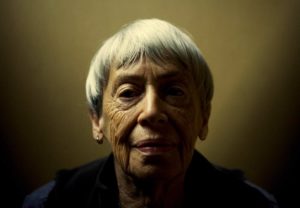
Photo by Benjamin Reed
Elizabeth Goudge: The Little White Horse. I’m a little embarrassed about this one, to be honest. Goudge’s work is imbued with a longing for a pre-modern English world, while also being deeply Christian. She appears to have been utterly untroubled by concerns such as breaking down class barriers, and (in The Little White Horse, anyway) is prone to describing the French using words like “swarthy” and indeed they — descended from invading Normans — are called the Black 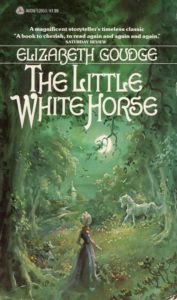 Men. But it all comes right in the end when Maria (a vain, selfish, materialistic, lonely girl with — you guessed it — red hair) is able to make her family legend come true through courage and loyalty and plain stubbornness. There’s a lion that everybody thinks is a dog who is about a hundred years old, and an intelligent hare, and yes, a unicorn. And everybody gets married in the end, even old Miss Heliotrope with the big purple nose that everyone thinks is due to drink but it’s just that she has indigestion due to being parted from her one true love while young. Like Tolkien, Goudge wrote about food — a lot (one could speculate that food rationing during the wars had more than a little to do with a certain Brit Lit obsession with joyfully describing, at great length, what characters eat). How I loved that book! Goudge also wrote the perhaps-better-known Linnets and Valerians for children, and a number of adult books too, all infused with enchantment where things coalesce magically (critical readers might say “in a contrived fashion,” but I say that comes out of that fake dichotomy where “literary realism” is somehow better than “genre”). There’s an overarching spirituality in her work — a sense of the unseen world — animals and bees and unicorns and destiny and springs bubbling out of abandoned church floors on the tops of hills…
Men. But it all comes right in the end when Maria (a vain, selfish, materialistic, lonely girl with — you guessed it — red hair) is able to make her family legend come true through courage and loyalty and plain stubbornness. There’s a lion that everybody thinks is a dog who is about a hundred years old, and an intelligent hare, and yes, a unicorn. And everybody gets married in the end, even old Miss Heliotrope with the big purple nose that everyone thinks is due to drink but it’s just that she has indigestion due to being parted from her one true love while young. Like Tolkien, Goudge wrote about food — a lot (one could speculate that food rationing during the wars had more than a little to do with a certain Brit Lit obsession with joyfully describing, at great length, what characters eat). How I loved that book! Goudge also wrote the perhaps-better-known Linnets and Valerians for children, and a number of adult books too, all infused with enchantment where things coalesce magically (critical readers might say “in a contrived fashion,” but I say that comes out of that fake dichotomy where “literary realism” is somehow better than “genre”). There’s an overarching spirituality in her work — a sense of the unseen world — animals and bees and unicorns and destiny and springs bubbling out of abandoned church floors on the tops of hills…
I just looked Goudge up on Wikipedia and found this quotation from her that made me cry:
“As this world becomes increasingly ugly, callous and materialistic it needs to be reminded that the old fairy stories are rooted in truth, that imagination is of value, that happy endings do, in fact, occur, and that the blue spring mist that makes an ugly street look beautiful is just as real a thing as the street itself.”
 Star Trek: The original TV series. I am not so old that I saw the episodes as they aired, but even our limited reception in Newfoundland got us re-runs in the 1970s. My first television crushes were Spock and Uhura; I would vacillate wildly between the two, unable to decide. Spock’s lonely position as the only Vulcan — and a half-Vulcan at that, belonging fully to neither culture — was a win, as was his strangely compelling blue eyeshadow. But Uhura was so capable, not to mention gorgeous. I only wish there’d been more episodes with her taking a bigger role, but maybe too that left us more space in which to imagine stories starring her. Special shoutout to Gene Roddenberry who, while costuming female characters in short skirts (I mean, how horrible, how I hated looking at Uhura and Christine Chapel’s gams), also created a world where there was putative equality between sexes and races. He was writing a future we didn’t have yet, and still don’t, and I want to know why.
Star Trek: The original TV series. I am not so old that I saw the episodes as they aired, but even our limited reception in Newfoundland got us re-runs in the 1970s. My first television crushes were Spock and Uhura; I would vacillate wildly between the two, unable to decide. Spock’s lonely position as the only Vulcan — and a half-Vulcan at that, belonging fully to neither culture — was a win, as was his strangely compelling blue eyeshadow. But Uhura was so capable, not to mention gorgeous. I only wish there’d been more episodes with her taking a bigger role, but maybe too that left us more space in which to imagine stories starring her. Special shoutout to Gene Roddenberry who, while costuming female characters in short skirts (I mean, how horrible, how I hated looking at Uhura and Christine Chapel’s gams), also created a world where there was putative equality between sexes and races. He was writing a future we didn’t have yet, and still don’t, and I want to know why.
These are all things from my childhood. Do we stop developing “favorite things” past the age of 25? Perhaps we do, but they don’t cut as deep. Are they ephemeral, continually replaced by new, sometimes fleeting enthusiasms and bizarre allegiances? But passion is still possible. There are many works I discovered later in life and they have my fealty, including:
The Parables Series by Octavia E. Butler. In Lauren Oya Olamina, Butler created one of my all-time favorite protagonists: difficult, tough, and gripped by a spiritual vision larger than herself. Her Earthseed is a religion I could actually get behind, although I persist in the foolish idea that maybe we as a species will come to our senses and take on climate change before we have to abandon ship and flee to the stars… Butler also had the courage to write some bitter criticisms of Lauren in the second book; Parable of the Talents features clear-eyed and irrefutable glimpses of what it was like to be her daughter, and it isn’t pretty. Butler was an unflinching oracle of prophesy, and a gorgeous writer.
The Marrow Thieves. Cherie Dimaline’s YA book had me hooked from the opening quotations from two of my favorites (William S. Burroughs, and Cormac McCarthy’s The Road) to the awesome and heartbreaking yet hopeful ending. As Waubgeshig Rice (author of Moon of the Crusted Snow) says,
“But really, any Indigenous literature, whether fiction or non-fiction, is post-apocalyptic.”
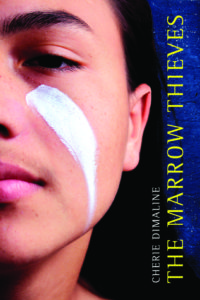 It’s winning all the things and feeling all the feels and the writing is stunning.
It’s winning all the things and feeling all the feels and the writing is stunning.
I have other favorites: Riddley Walker by Russell Hoban — what kind of a weirdo doesn’t love this book? — John Wyndham’s The Chrysalids, Alan Garner’s Red Shift, Geoff Ryman’s The Child Garden; and yes, I loved the first Star Wars movies and The X-Files, and so much more.
My mother told me that my first word was “more.” Our origin stories rest in the hands of our elders, and my mother was known to go out on more than a few limbs, but nothing in my life thus far has given me reason to disbelieve this story. I have too many favorite things. My first memory, nearly pre-verbal, of a favorite thing (besides food) was the Fairy Rock. Laugh if you must. I grew up on what was then the very outskirts of St. John’s, Newfoundland, in the shadow of the Southside Hills, and there were lots of strange stories about the place and still are. Not too far from my house, up the steep slope, was a big, dark grey rock (about the size of a Smart car) furred with black lichen. It was round and smooth and embedded in the ground. It lay in a perfectly circular depression, with a perfect circle of blueberry bushes around the rim, and no matter the weather it always felt cold. A glacial erratic? A meteorite? My father called it the Fairy Rock: possibly because he believed in the Little People, possibly because he thought I’d like the idea, possibly because he wanted to scare me — he once told me he identified as a Godwinian Anarchist so, none or all of the above? I spent an awful lot of time up there as a youngster, dreaming desperately about traveling to other worlds, and I didn’t much care if it was aliens or the Fair Folk who took me. When I was still young they paved it over with a highway. Is the Fairy Rock a speculative thing? You decide.
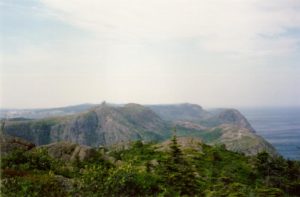
Signal Hill, not Fairy Rock, but taken from Southside Hills, where Fairy Rock once resided.
When it comes to speculative things, I can only echo my childhood self’s first spoken word, and say, “More.”
 Kate Story is a writer and performer. A Newfoundlander living in Ontario, her first novel Blasted (Killick Press) received honorable mention for the Sunburst Award. Her short fiction has been published in World Fantasy-nominated and Aurora Award-winning collections, and in Imaginarium 4: The Best Canadian Speculative Writing. She is the 2015 recipient of the Ontario Arts Foundation’s K.M. Hunter Award for her work in theatre. In 2017 her third novel This Insubstantial Pageant came out with ChiZine Publications; it’s The Tempest… in space! Toronto Star named it a “top science-fiction read… exotic, funny and very sexy.” Her YA fantasy novel Antilia: Sword and Song came out in 2018 with ChiZine Publications, and the second and final installment Antilia: Seer and Sacrifice comes out May 21st, 2019. “You know a good book as soon as you start it. It sings to you and makes an immediate connection. That’s what happened to me with Kate Story’s Antilia. I loved everything about the book.” (Charles de Lint, author of The Onion Girl and The Wind in His Heart). You can find Kate on Facebook, and her horribly out-of-date website is katestory.com
Kate Story is a writer and performer. A Newfoundlander living in Ontario, her first novel Blasted (Killick Press) received honorable mention for the Sunburst Award. Her short fiction has been published in World Fantasy-nominated and Aurora Award-winning collections, and in Imaginarium 4: The Best Canadian Speculative Writing. She is the 2015 recipient of the Ontario Arts Foundation’s K.M. Hunter Award for her work in theatre. In 2017 her third novel This Insubstantial Pageant came out with ChiZine Publications; it’s The Tempest… in space! Toronto Star named it a “top science-fiction read… exotic, funny and very sexy.” Her YA fantasy novel Antilia: Sword and Song came out in 2018 with ChiZine Publications, and the second and final installment Antilia: Seer and Sacrifice comes out May 21st, 2019. “You know a good book as soon as you start it. It sings to you and makes an immediate connection. That’s what happened to me with Kate Story’s Antilia. I loved everything about the book.” (Charles de Lint, author of The Onion Girl and The Wind in His Heart). You can find Kate on Facebook, and her horribly out-of-date website is katestory.com
Author Photo by Wayne Eardley
Would you like to write about YOUR favorite things for Speculative Chic? Check out our guidelines and fill out the form here.

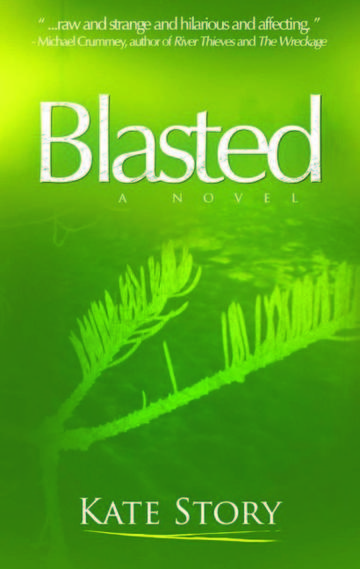
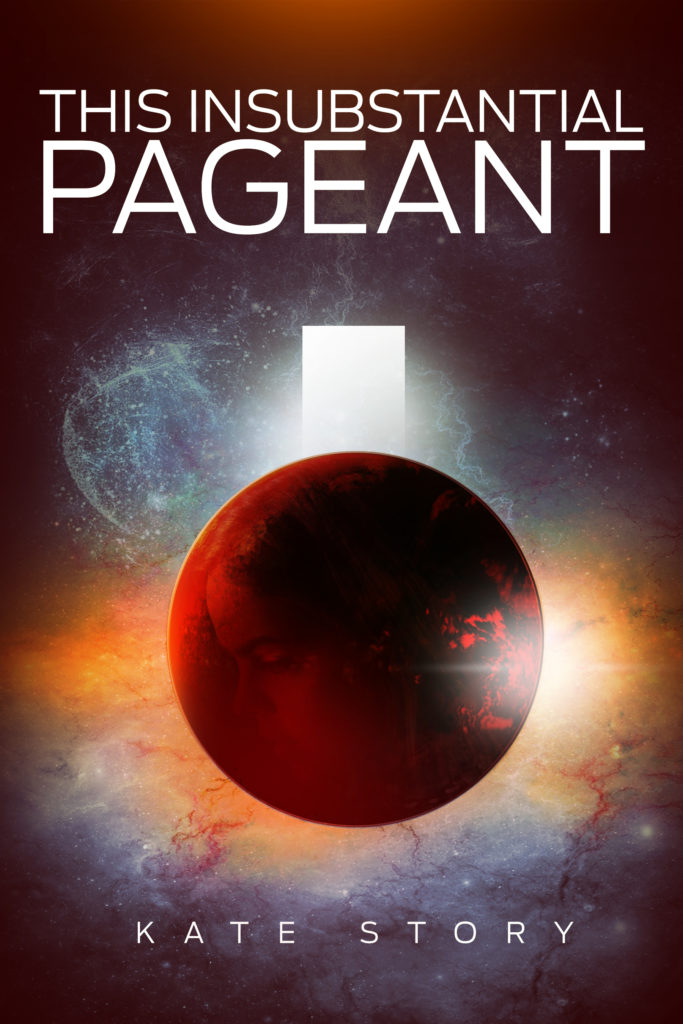
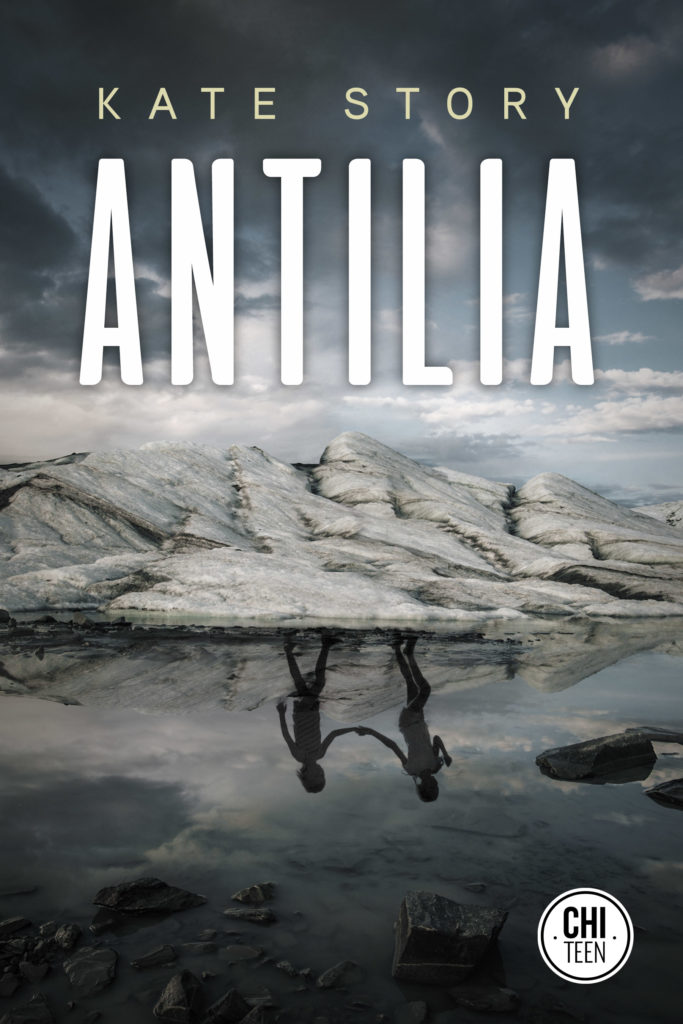
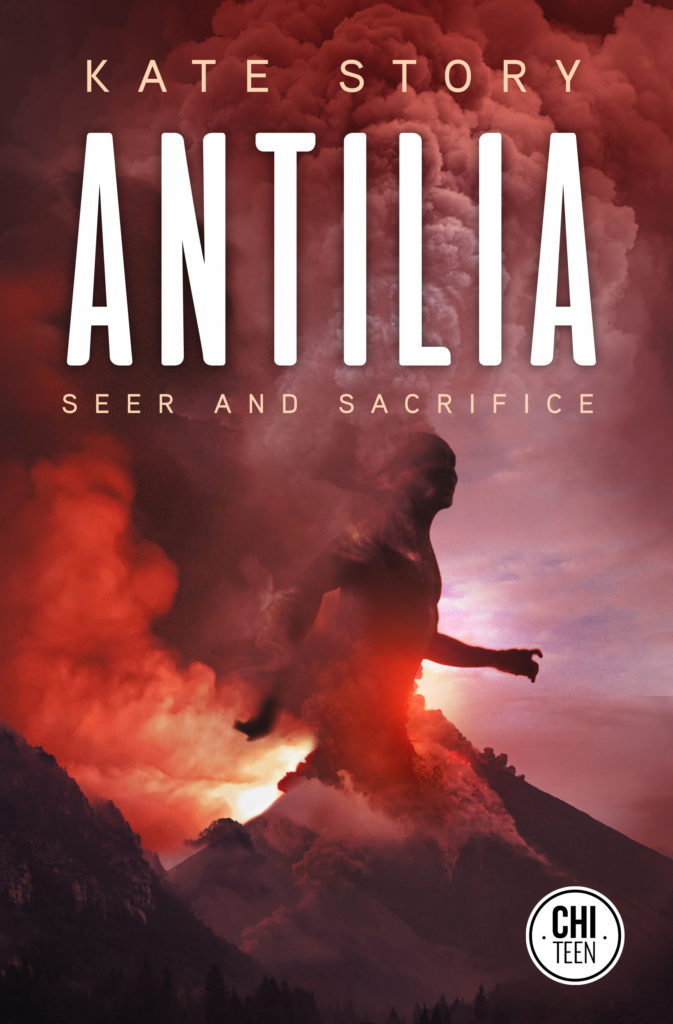


Have you read Trail of Lightning by Rebecca Roanhorse? It is also a post-apocalyptic story about indigenous people. I enjoyed it but thought it had some missteps. I wonder how it compares to The Marrow Thieves.
I am so grateful you included “Swan Lake” in your favorites. It’s such a dark, lovely fairytale with beautiful music, and part of what made me study ballet for ten years! I’ve kept up with all its iterations, too, from the corny “Swan Princess” to “Princess Tutu” and “Black Swan” (which I loved). Thanks for a great read!